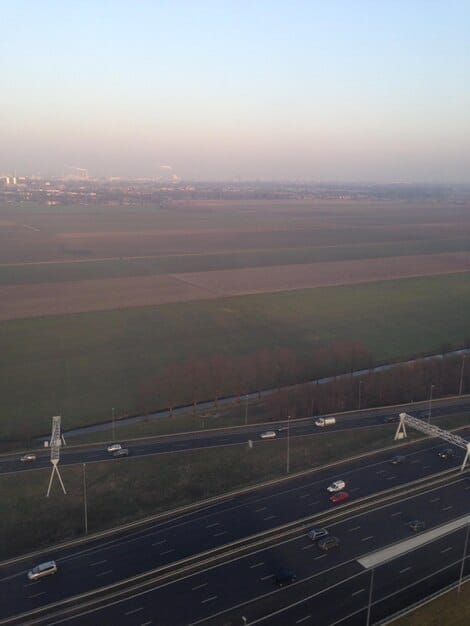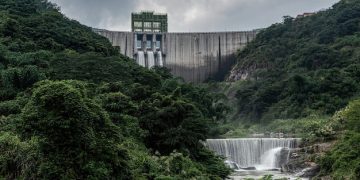Renewable Energy Integration: Shaping the Grid’s Future

Renewable energy integration is reshaping the electrical grid with innovative technologies, policy changes, and infrastructure adaptations to accommodate variable energy sources like solar and wind, ensuring a sustainable and reliable future energy supply.
The integration of renewable energy and the grid: How integration is shaping the future is not just a future aspiration but a present-day necessity. How is this integration reshaping our energy landscape?
Understanding Renewable Energy Integration
Renewable energy sources, such as solar, wind, and hydropower, are increasingly vital in meeting global energy demands and combating climate change. Integrating these sources into existing electrical grids presents both opportunities and challenges.
This section explores the fundamental concepts of renewable energy integration, its significance, and the key factors influencing its successful implementation worldwide.
The Basics of Grid Integration
Grid integration refers to the process of connecting renewable energy sources to the existing electrical grid infrastructure. This involves ensuring that the intermittent and variable output of renewables can be managed to maintain grid stability and reliability.
Why Grid Integration Matters
Effective grid integration is crucial for maximizing the potential of renewable energy. It allows for the efficient distribution of clean energy to consumers, reduces reliance on fossil fuels, and supports the transition to a sustainable energy future.

Successful renewable energy integration depends on several factors:
- Grid Infrastructure: Upgrading and modernizing the grid to handle variable energy flows.
- Energy Storage: Implementing storage solutions like batteries and pumped hydro to balance supply and demand.
- Smart Grid Technologies: Utilizing advanced monitoring and control systems for efficient grid management.
- Policy and Regulation: Establishing supportive policies and regulations to incentivize renewable energy development.
In summary, understanding the basics of renewable energy integration and its importance is the first step towards achieving a sustainable and reliable energy future.
Challenges in Integrating Renewable Energy
While the integration of renewable energy offers numerous benefits, it also presents significant challenges that must be addressed to ensure a stable and reliable electricity supply. These challenges range from technical issues to economic and regulatory hurdles.
This section delves into the primary challenges encountered during renewable energy integration and explores potential solutions to overcome them.
Intermittency and Variability
One of the most significant challenges is the intermittent and variable nature of renewable energy sources like solar and wind. Unlike traditional fossil fuel-based power plants, these sources depend on weather conditions, which can fluctuate unpredictably.
To mitigate this, solutions include:
- Energy Storage Systems: Using batteries or pumped hydro to store excess energy for later use.
- Diversification: Combining different renewable energy sources to create a more stable supply.
- Improved Forecasting: Developing more accurate weather forecasting models to predict energy output.
Grid Stability and Reliability
Integrating large amounts of variable renewable energy can impact grid stability and reliability. Fluctuations in power output can cause voltage and frequency deviations, potentially leading to grid instability.
Strategies to address this include:
- Advanced Grid Management: Implementing smart grid technologies to monitor and control energy flows in real-time.
- Synchronous Condensers: Installing devices that provide inertia to the grid, helping to stabilize frequency.
- Upgrading Transmission Infrastructure: Strengthening transmission lines to handle increased energy flows.

Economic and Regulatory Barriers
Economic and regulatory barriers can also impede the integration of renewable energy. High upfront costs, complex permitting processes, and outdated regulations can discourage investment and slow down project development.
Overcoming these barriers requires:
In conclusion, addressing these challenges is essential for realizing the full potential of renewable energy and securing a sustainable energy future.
Technologies Enabling Grid Integration
The successful integration of renewable energy into the grid relies on a range of advanced technologies that can address the challenges of intermittency, variability, and grid stability. These technologies include energy storage systems, smart grids, and advanced forecasting tools.
This section examines the key technologies that are enabling the integration of renewable energy and their roles in shaping the future of the grid.
Energy Storage Systems
Energy storage systems play a crucial role in balancing the supply and demand of electricity, especially when dealing with variable renewable energy sources. These systems can store excess energy generated during periods of high production and release it when demand is high or when renewable energy output is low.
Types of energy storage systems include:
- Batteries: Lithium-ion batteries are widely used for grid-scale energy storage due to their high energy density and fast response times.
- Pumped Hydro Storage: This involves pumping water uphill to a reservoir during periods of excess energy and releasing it through turbines to generate electricity when needed.
- Compressed Air Energy Storage (CAES): CAES systems store energy by compressing air and releasing it to drive turbines when electricity is required.
Smart Grid Technologies
Smart grid technologies enhance the efficiency, reliability, and security of the electrical grid by incorporating advanced monitoring, control, and communication systems. These technologies enable real-time data collection and analysis, allowing for optimized grid management.
Key components of smart grids include:
- Advanced Metering Infrastructure (AMI): Smart meters provide detailed information on energy consumption, enabling utilities to optimize energy distribution and encourage energy conservation.
- Sensors and Monitoring Devices: These devices monitor grid conditions, detect anomalies, and provide data for predictive maintenance.
- Communication Networks: High-speed communication networks enable real-time data exchange between grid components, facilitating rapid response to changing conditions.
Advanced Forecasting Tools
Accurate forecasting of renewable energy output is essential for effective grid management. Advanced forecasting tools use weather data, historical trends, and machine learning algorithms to predict the amount of energy that will be generated by solar and wind resources.
By leveraging these technologies, grid operators can better manage the integration of renewable energy and ensure a stable and reliable electricity supply.
Policy and Regulatory Frameworks
Government policies and regulatory frameworks play a critical role in promoting the integration of renewable energy into the grid. Supportive policies can incentivize investment, streamline permitting processes, and create a level playing field for renewable energy developers.
This section explores the key policies and regulations that are driving the integration of renewable energy and their impact on the energy landscape.
Renewable Portfolio Standards (RPS)
Renewable Portfolio Standards (RPS) are policies that require utilities to obtain a certain percentage of their electricity from renewable energy sources. These standards create a market for renewable energy and drive investment in new projects.
RPS policies vary by state, but they generally include:
- Mandatory Targets: Specific targets for renewable energy generation that utilities must meet.
- Compliance Mechanisms: Mechanisms for utilities to comply with the standards, such as purchasing renewable energy credits (RECs).
- Enforcement Provisions: Penalties for utilities that fail to meet the RPS targets.
Feed-in Tariffs (FIT)
Feed-in Tariffs (FIT) are policies that offer guaranteed payments to renewable energy producers for the electricity they generate. These tariffs provide long-term revenue certainty, encouraging investment in renewable energy projects.
Interconnection Standards
Interconnection standards govern the process by which renewable energy projects connect to the electrical grid. Streamlined and transparent interconnection standards can reduce the time and cost associated with connecting new projects to the grid.
In conclusion, supportive policies and regulatory frameworks are essential for accelerating the integration of renewable energy and achieving a sustainable energy future.
Case Studies: Successful Grid Integration Projects
Examining real-world examples of successful grid integration projects provides valuable insights into the strategies and technologies that are most effective. These case studies demonstrate how various regions and countries have successfully integrated renewable energy sources into their grids.
This section highlights several notable case studies and the lessons learned from their experiences.
Germany has been a leader in renewable energy integration, with a high percentage of its electricity coming from solar and wind. Key strategies include:
- Aggressive RPS Targets: Setting ambitious targets for renewable energy generation.
- Investment in Grid Infrastructure: Upgrading transmission lines and implementing smart grid technologies.
- Energy Storage Systems: Deploying batteries and pumped hydro storage to balance supply and demand.
California, USA
California has also made significant progress in renewable energy integration, with ambitious targets for reducing greenhouse gas emissions. Key strategies include:
- Renewable Portfolio Standard: Requiring utilities to obtain a certain percentage of their electricity from renewable sources.
- Energy Storage Mandates: Mandating utilities to procure energy storage capacity to support renewable energy integration.
- Smart Grid Initiatives: Investing in smart grid technologies to improve grid management.
Denmark
Denmark has successfully integrated a high percentage of wind energy into its grid. Key strategies include:
- Strong Interconnections: Establishing strong interconnections with neighboring countries to balance supply and demand.
- Advanced Forecasting: Developing accurate weather forecasting models to predict wind energy output.
- Flexible Grid Management: Implementing flexible grid management strategies to accommodate variable wind energy production.
By examining these case studies, valuable lessons can be learned about the strategies and technologies that are most effective for integrating renewable energy into the grid.
Future Trends and Innovations
The integration of renewable energy into the grid is an ongoing process, with new technologies and innovative approaches constantly emerging. These future trends and innovations promise to further enhance the efficiency, reliability, and sustainability of the grid.
This section explores some of the key trends and innovations that are expected to shape the future of renewable energy integration.
Advanced Energy Storage Technologies
Ongoing research and development are leading to the emergence of new and improved energy storage technologies, such as:
- Solid-State Batteries: Offering higher energy density, improved safety, and longer lifespans compared to traditional lithium-ion batteries.
- Flow Batteries: Providing scalable and long-duration energy storage for grid-scale applications.
- Thermal Energy Storage: Storing energy in the form of heat or cold for later use in heating and cooling applications.
Artificial Intelligence (AI) and Machine Learning (ML)
AI and ML are being increasingly used to optimize grid management, improve forecasting accuracy, and enhance the efficiency of renewable energy integration. Applications include:
- Predictive Maintenance: Using AI to analyze grid data and predict equipment failures, reducing downtime and improving reliability.
- Demand Response Optimization: Leveraging AI to optimize demand response programs, shifting energy consumption to periods of high renewable energy production.
- Grid Optimization: Using AI to balance supply and demand in real-time, ensuring grid stability and reliability.
Microgrids and Distributed Energy Resources (DER)
Microgrids and DER are playing an increasingly important role in the integration of renewable energy. Microgrids are localized energy grids that can operate independently or in conjunction with the main grid, providing resilience and flexibility.
By embracing these future trends and innovations, the grid will become more efficient, reliable, and sustainable, paving the way for a cleaner energy future.
| Key Point | Brief Description |
|---|---|
| ☀️ Intermittency Mitigation | Using energy storage and diversification to stabilize renewable energy supply. |
| ⚡ Smart Grids | Advanced systems for efficient monitoring and control of grid energy flows. |
| 📜 Policy Support | Government policies that incentivize renewable energy and streamline processes. |
| 🤖 AI Optimization | Artificial intelligence enhances forecasting, maintenance, and demand management. |
Frequently Asked Questions
▼
Renewable energy integration is the process of incorporating renewable energy sources into the electrical grid to ensure a reliable and sustainable electricity supply. It involves managing variable output.
▼
Grid integration is important because it allows for the efficient distribution of clean energy, reduces reliance on fossil fuels, and supports the transition to a sustainable energy future. It maximizes renewable potential.
▼
The main challenges include the intermittency of renewable sources, grid stability issues, and economic and regulatory barriers. Overcoming these challenges is crucial for a reliable supply.
▼
Technologies such as energy storage systems, smart grids, and advanced forecasting tools enable the integration of renewables. These enhance efficiency and reliability for electricity delivery.
▼
Government policies and regulatory frameworks play a crucial role by incentivizing investment, streamlining processes, and promoting renewable energy development to pave way for sustainable pathways.
Conclusion
In conclusion, the integration of renewable energy and the grid: How integration is shaping the future represents a monumental shift in the energy sector, promising a more sustainable, reliable, and environmentally friendly future. By addressing the challenges and embracing innovative solutions, we can pave the way for a cleaner and more resilient energy landscape.





